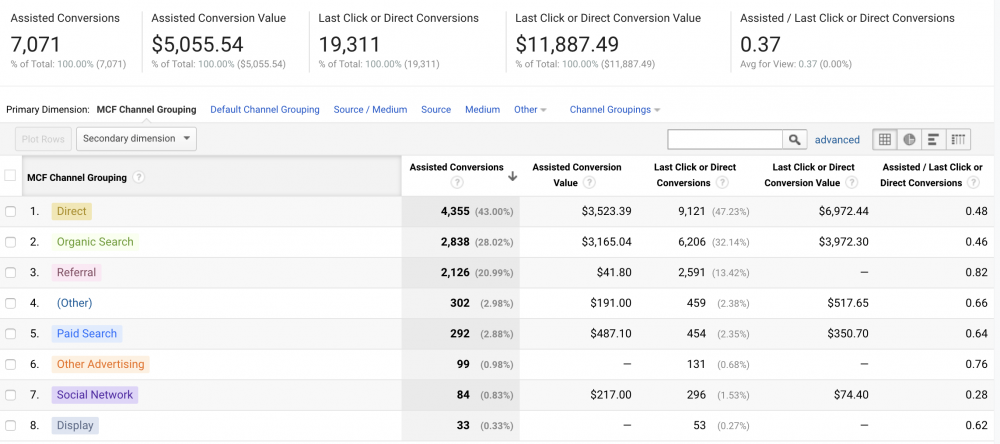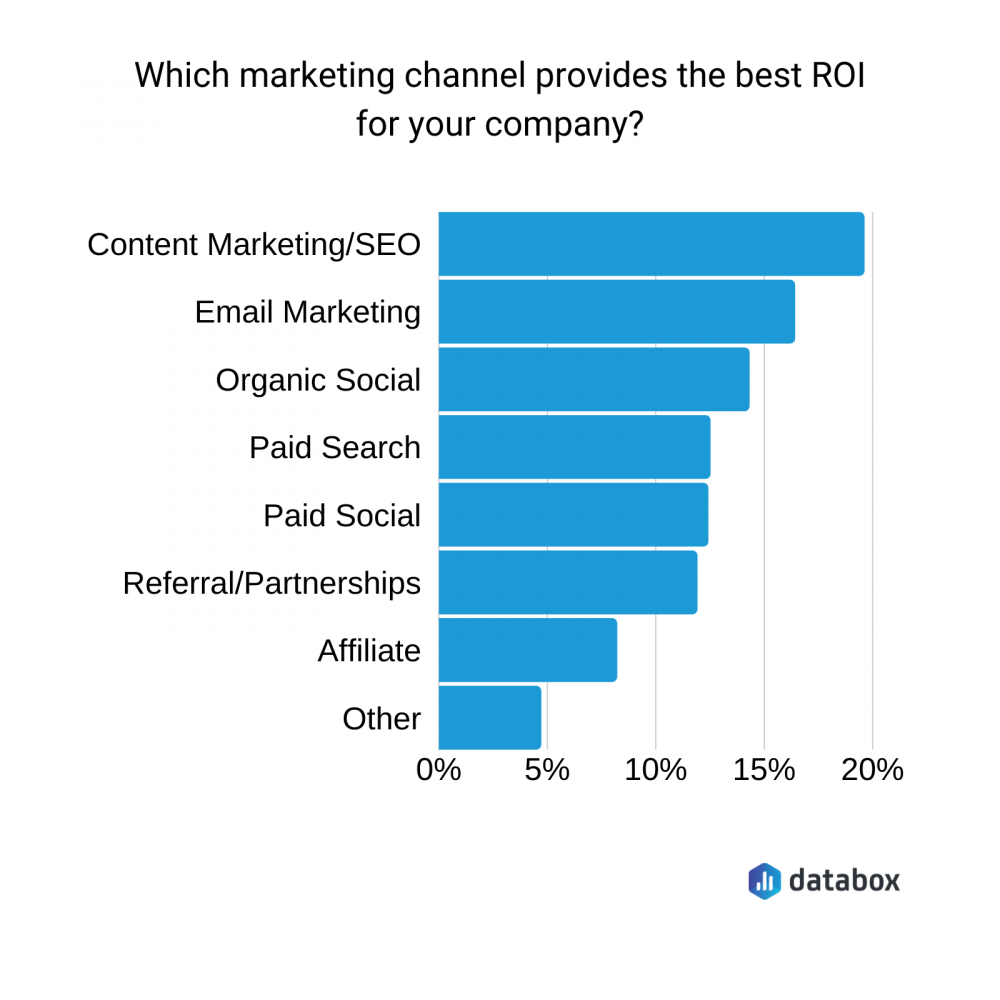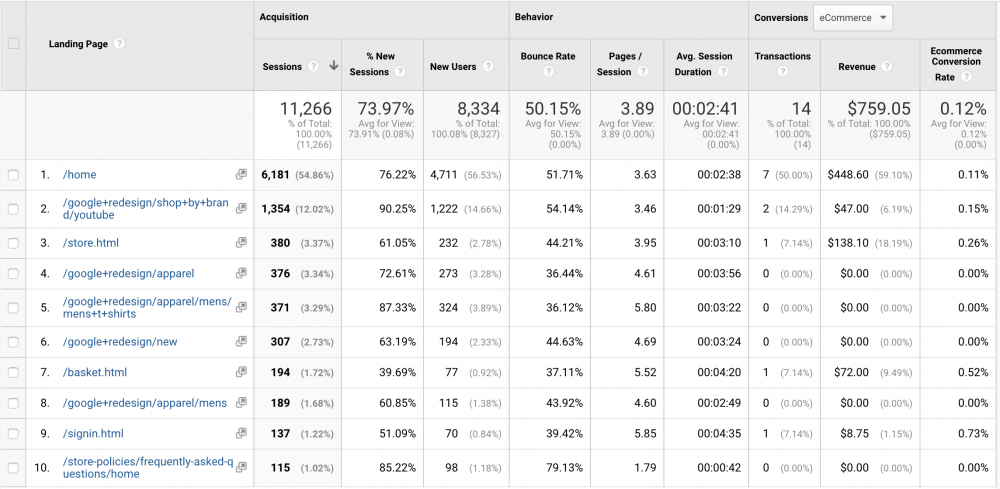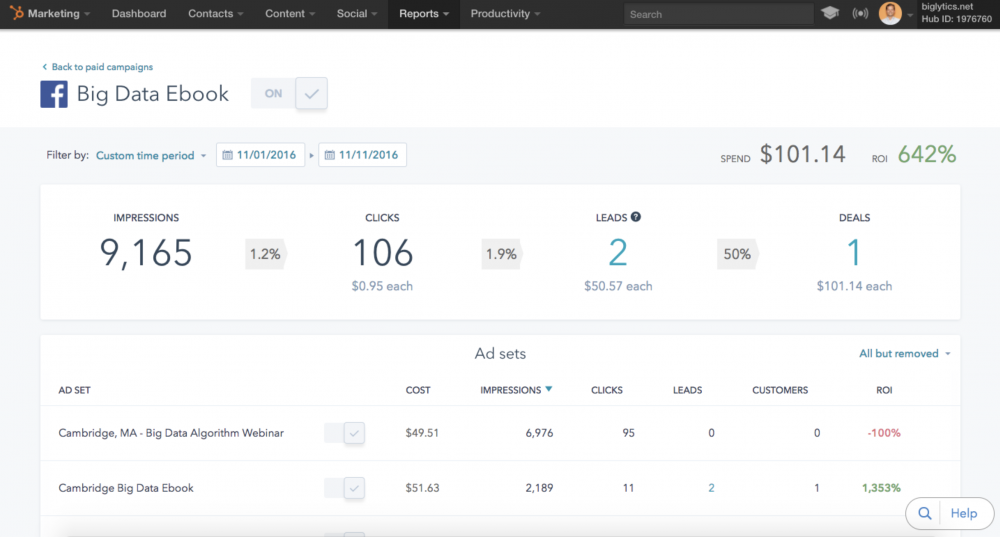Table of contents
Did you know that just 39% of marketers feel confident about tracking the ROI of their campaigns?
While some readers may not be confident in their ability to properly report on ROI, it’s a critical exercise not only for reporting the effectiveness of your team and strategy, but also for determining what the strategy should look like going forward.
Says Growth-Hackers‘ Jonathan Aufray: “It’s extremely important to track the ROI of your marketing campaigns to understand what works and what doesn’t in order to optimize what doesn’t work and double down on what works.”
“You need to know how much you spend in marketing (how much to create content, how much spent in advertising, how much for your marketing reporting software, how much for your marketing staff, etc.) and how many sales you make thanks to these campaigns.”
What is ROI?
Put simply, return-on-investment (ROI) is the ratio between the money you’ve made (profits) and the money you’ve spent (costs).
A high ROI means higher profits in relation to the amount spent. A low ROI means lower profits in relation to the amount spent. Obviously, companies want a higher ROI and may make adjustments to their cost structure in order to do so.
How do You Calculate Marketing ROI? 7 Popular Marketing ROI Formulas
We wanted to find out how businesses who do track the ROI of their marketing activities actually do the data calculation for it.
So, we asked them to share their formulas, which included:
- Money spent vs. money generated
- Time spent vs. money generated
- Sales growth — marketing spend
- (Ad spend / new customers) × customer LTV
- Cost per session vs. cost per inquiry
- Google Analytics reports
- Calculate your profit margin
PRO TIP: How Are Users Engaging on My Site? Which Content Drives the Most Online Activity?
If you want to discover how visitors engage with your website, and which content drives the most engagement and conversions, there are several on-page events and metrics you can track from Google Analytics 4 that will get you started:
- Sessions by channel. Which channels are driving the most traffic to your website?
- Average session duration. How long do visitors spend on your website on average?
- Pageviews and pageviews by page. Which pages on your website are viewed the most?
- Total number of users. How many users engaged with your website?
- Engagement rate. Which percentage of your website visitors have interacted with a piece of content and spent a significant amount of time on the site?
- Sessions conversion rate. How many of your website visitors have completed the desired or expected action(s) and what percentage of them completed the goals you’ve set in Google Analytics 4?
And more…
Now you can benefit from the experience of our Google Analytics 4 experts, who have put together a plug-and-play Databox template showing the most important KPIs for monitoring visitor engagement on your website. It’s simple to implement and start using as a standalone dashboard or in marketing reports!
You can easily set it up in just a few clicks – no coding required.
To set up the dashboard, follow these 3 simple steps:
Step 1: Get the template
Step 2: Connect your Google Analytics account with Databox.
Step 3: Watch your dashboard populate in seconds.
1. Money Spent vs. Money Generated
“I calculate my ROI by keeping tracking of two simple metrics: how much I spend, and how much I make,” writes James Zanzanella of Isolated Marketing Nights.
“This is very easy to do, as I can see all of my expenses in Quickbooks, and all of my sales get tracked through each affiliate offer that I promote. As long as I’m bringing in more money than I’m spending, I’m going to keep on investing more in growing my online business.”
“I’ve learned to keep the process as simple as possible because, at the end of the day, it’s all about money invested versus money made.”
Jumpstart Go‘s David Denning puts that into practice: “If we’re running ads (for example), we would look at how much sales revenue we generated from that ad versus what we spent in ad spend. We then compare ROI’s for different ads, marketing channels, etc. to determine which are the best investments for our marketing budget.”
“Many companies will use metrics like ROAS, or return on ad spend, that compare the invested marketing dollars to the revenue the marketing campaigns have generated.”
“These metrics do not factor in your business’ cost of goods sold (COGS), and therefore cannot be used to measure how profitable a marketing investment is,” Hogan explains.
Mavens & Moguls‘ Paige Arnof-Fenn also says: “It can be difficult to figure out which incremental profits are attributable to which programs since most companies are using a mix of programs to persuade customers to buy.”
Chima Mmeje of Zenith Copywriting Agency explains how to overcome it: “Some people may see your ad and convert immediately, others take more time. It’s tricky to calculate conversion that didn’t come through concerted efforts like landing pages and social media advertising.”
“I use tools like Google Campaign URL Builder or Google Analytics to set conversion goals, values and measure analytics. The formula works up to revenue — investment = ROI.”
2. Time Spent vs. Money Generated
“We track our marketing’s ROI by comparing the time spent on certain projects with conversion rates of whatever goal we choose for it,” writes Channels‘ Jakub Kliszczak.
“Of course, the ROI itself will be represented in new customers -> $ value but we want to get a closer look at what is worth repeating and experimenting with. Thus, we not only want to know what’s the ROI itself but rather what’s the ROI compared to time spent on it.”
“Thus, we measure the time spent on a project, a result that it generated (new users, visitors, readers, downloads) and what’s the value of that result.”
Kliszczak adds: “In the end, we get a clear view of what we achieved and, what’s most important, we not only know whether it was time/money well spent but also whether we want to do it once more.”
3. Sales Growth — Marketing Spend
Manish Dudharejia explains that for E2M Solution, “our point of view is that if you don’t measure your marketing success, you’ll never learn to grow.”
“Typically, we calculate our marketing spend first. This includes all continual expenses, team expenses, hiring costs, etc. We then calculate our sales growth. The goal is to remove as many extraneous variables as possible, but since that’s extremely challenging, we do the best we can.”
“Subtract the marketing cost from your sales growth, divide everything by your marketing cost, and voila. You’ve got an estimated ROI for your marketing strategy,” Dudharejia adds.
“We calculate ours at least on an annual basis and strive to create as many comparisons as possible. Because marketing is such a subjective, hard-to-measure concept, we’ve found that the more comparisons we have over time, the better we’re able to understand and repeat successful campaigns.”
Upgrow‘s Joel A. Almazar adds that you should “take the sales growth from that business or product line, subtract the marketing costs, and then divide by the marketing cost.”
“Let’s say you earned $100 in sales and you spent $10 on your marketing campaign. The ROI is 9% [using the formula] (($100 – $10) / $10) = 9%.”
4. Ad Spend / New Customers × Customer LTV
“We measure quarterly ad spend against the number of new customers brought in by those ads, multiplied by the average lifetime value of a customer,” Morgan Taylor of Let Me Bank explains.
“We learned long so that you can’t track base your decisions on how much they spend initially, you need to average out the lifetime values. It doesn’t have to be ad spend, specifically, any marketing expense works just the same, from content marketing to billboards.”
Taylor explains: “You also need to split your metrics by demographic and acquisition source, as some sources that lead to high initial purchases or leads, are of lower value in the long run.”
Michelle Symonds explains that Ditto Digital “also takes into account other influencing factors, in particular Customer Lifetime Value (CLV). This metric has proved to be a better measure of ROI than the initial increase in profit because it generates ongoing or repeat business long after the initial marketing campaign has finished.”
5. Cost per Session vs. Cost per Inquiry
“We calculate marketing ROI but looking at the cost per session and cost per inquiry,” Charlie Worrall of Imaginere Digital explains.
“With this, let’s say the average inquiry is worth £3000 and we spend £1000 on marketing each month. If that £1000 worth of marketing brings in 30 leads, that is potential £90,000 worth of business.”
Worrall adds: “Then, tracking the number of sales made will show that the bottle nack is the sales team not marketing. This is all done through a custom dashboard that we’ve built with a custom dashboard software.”
6. Google Analytics ROI Reports
Fancy some good news?
You don’t have to rely on complex math formulas to determine how much return you’re getting on your marketing investment.
“For most paid media, our ROI is calculated with Google Analytics,” says Russell Michelson of PharMed. “It takes the guesswork out of calculating ROI, and the attribution reporting continues to improve within the platform.
Hosting Canada‘s Gary Stevens adds: “You can also look at attribution models and which one is best for your business based on how many touchpoints are involved.”
“While a single-touchpoint attribution method might seem easier, a multi-touchpoint attribution method could provide you with more accurate results, helping you with your plans to move forward.”

It’s also how the team at Outlier Creative track their marketing ROI, as Jenna Alburger explains: “The first step is understanding what content and channels are converting.”
“Google Analytics helps set up attribution models, so that we know exactly where our leads are coming from. It’s easy to overlook the ROI of our content marketing / SEO activities because the conversion funnel is longer and there are more steps before a customer completes a goal. It’s not as easy as calculating the ROI of a paid ad, for example, where the attribution model is more simple.’
“But, we find that content marketing is by far one of the highest performing channels over the long-term. On average, our clients see that people who subscribe to their blog are 50% more likely to become paying customers than non-subscribers. That’s a big difference,” Alburger says.
DotComBlinds‘ Buzz Carter explains: “If someone finds your site via PPC, but only browses your site, but then comes back in 2 days time as direct traffic and purchases something, you can see how many ‘assists’ each channel has given you, then again, you just run that against your marketing spend to work out what the ROI for each channel is.”
In fact, these experts aren’t alone. Content marketing provides the best ROI for most businesses:

7. Don’t Forget Your Profit Margin
The majority of ROI formulas we’ve shared so far focus on the money generated.
However, SoftwarePundit‘s Bruce Hogan adds: “When calculating marketing ROI, the most important thing to remember is to compare your marketing investment to the gross margin dollars that the investment has generated – not to the top-line revenue.”
alphawhale‘s Nick Montagu agrees: “Our recommendation is to drive the ROMI from the e-commerce analytics side, or let’s say, not from advertising platforms as from here there will be cross-share attribution, whereas your analytic platform, (i.e. enhanced e-commerce Google Analytics) will be strictly the revenue that you made.”
“As an example: if Facebook and Google were both in the conversion path, they will both have a level of attribution in the ad reporting for the return on ad spend, but you only made one sale. We tend to take the return on ad spend based on what analytics provides us, which isn’t the whole truth, but it’s the most conservative truth.”
Montagu continues: “If your ROMI is 5:1, for example, every dollar you spend on advertising, you’re making $5 in revenue, but your margin is 20%, then your real net-net ROI is zero, however in terms of your customer lifetime value, it might mean your customer acquisition benefit is zero, but if that customer shops with you 2-3 times a year you’ll continue to make money from them.”
What About ROI for Non-Revenue-Generating Tasks?
Not all of your marketing campaigns will generate revenue–but that doesn’t mean you can’t track their ROI.
Here’s how our experts track the ROI of non-revenue-related marketing tasks:
Backlinks Generated
Bernard Wong explains that VC Commerce “sometimes produce content with the purpose of getting backlinks, and those are harder to quantify in terms of dollars. For those instances, we would gauge the quality of the backlink and how it affects our Domain Rating.”
“If the backlink produces a tangible improvement in our DR, we would gauge the return on investment based on an estimate on how much would we have needed to pay to buy those links. While this isn’t common practice these days, there are sites that still charge for backlinks, and those are the only benchmark we have.”
“As far as tools go, we use Ahrefs, Hunter, and Mailshake to run backlink campaigns. From doing this for the past few years, we learned that a systematic approach backed by keyword research data yields the most predictable results for content marketing,” Wong explains.
Keyword Performance
“We track out ROI for marketing in a couple of different ways. From overall visitors to new keywords and conversions,” Catherine Way of Hard Money Lender Arizona explains.
“Our traffic helps us track and see what sources are gathering the most visitors, and conversions see where those money conversions come from, and what we need to do to increase. Because we are a high research product it is hard to get conversions on a first visit, but seeing our keyword net improve helps us track our SEO efforts, and we can develop long term customers from these routes.”
Kristel Staci adds that for BloggingTips.com, “we focus a lot of time and effort on our content creation and marketing efforts, which ultimately improves our search rankings and traffic to the site.”
“Once a visitor hits our site, we have many ways to track and measure new leads and revenue. However, something we pay a lot of attention to is our search rankings and how we can improve them.”
“To do this, we use Ahrefs to keep an eye on new and lost keywords and competitor rankings as well. By continually looking at these numbers and trends, we continue to see month over month improvement across the board.”

Related: Here’s How to Use Ahrefs for SEO (According to 97 Marketers)
Assign Monetary Values to Non-Financial Wins
Jeremy Cross explains that “a few years ago [Corporate Events NYC] created an ROI spreadsheet that assigns dollar values to various marketing wins.”
“For example, a major media feature could be worth $5000 and a link from a very low domain authority site could be worth $10. We have numbers for leads, comments, likes, shares and similar. “
“While the assigned value is somewhat arbitrary, this system provides clear guideposts to our team and lets them know how they are doing with value creation,” Cross adds.
(You can do this inside Google Analytics with goal values.)
Look for Trends with Sales and Campaign Launch Dates
“It’s wise to not lose sight of the big picture and also look for corollary effects with your marketing too,” writes Wes Marsh of eRep CPQ by BCA Technologies. “This is especially important when your marketing strategies include activities that do not have a direct impact.”
“For example, we have run campaigns across internet radio along with digital display ads and what we’ve seen from tracking is that there was a direct correlation between our lead volumes when the ads were running compared to when they were not.”
Marsh continues: “Although I could not see a direct impact showing that the users were influenced by the display ads or internet radio ads, the impact was obvious when looking at the overall results. The big takeaway is to not miss the forest for the trees.”
Bonus: 6 Tips to Track Your Marketing ROI
You can use either of these ROI formulas to track the impact of your marketing campaigns.
Here are six bonus tips to make the entire process easier.
1. Sync Your CRM and Campaign Data
“Our most successful tracking of ROI from our marketing efforts is when we connect a client’s campaigns to their CRM,” Conduit Digital‘s Mike Gibson explains.
“By correctly tracking leads in a client’s CRM and using tracking templates within an advertising platform, we are able to see exactly which channels/keywords/ad copy is driving the most leads and also the revenue associated with these leads. By having access to this revenue data, we are able to calculate cost per lead by channel and optimize correctly.
Gibson continues: “Furthermore, when tools like Google Analytics and Campaign Manager are incorporated into this process, we can successfully identify popular conversion paths of customers which allow us to further optimize our efforts.”
Portent‘s Oeuyown Kim explains: When possible, we track final sales through Closed Loop Analytics by either importing offline sales data from our client’s CRM or blending the acquisition data from Google Analytics with the CRM data in Google Data Studio.”
“We’re able to calculate ROI by attributing final and offline sales dollars to the original acquisition source and comparing the dollar value of those sales directly to spend.”
Plus, Ryan Dunagan of SPOTIO adds: “We use a parent/child lead attribution model that passes from HubSpot into Salesforce. The model measures the first touch and last touch of each lead so we can see how each channel is performing all the way through the funnel.”
“We keep a live dashboard in Salesforce where we can see where our best leads, opportunities, and wins are coming from and make educated decisions on ROI and program spending.”
Amanda Sleger of Leighton Interactive also says: “It’s important to have some form of lead attribution so you know where your customers are coming from.“
“With clients we typically pull a list of their leads and sources for regular review. We have candid discussions around the quality of leads, if the sources they are coming from are worth the investment, if the content/design we are using on various channels is attracting the right leads and encouraging the right actions.”
“We use HubSpot, Salesforce, Google Analytics, and a tracking sheet. This prompts us to move budget to channels and efforts that are delivering on quality leads.”*Editor’s note: Whether you use HubSpot, Pipedrive, or Salesforce, we’ve got dashboards that pull data from your account and show it on one page. Marketing dashboards are the easiest way to track the revenue impact of your marketing campaigns.
2. Calculate ROI by Influencer (or Affiliate)
According to MonsterInsights‘ Frank Spear, “you should consider creating links for affiliates and influencers to determine where your best ROI comes from based on individual performance.”
Kevin Miller of The Word Counter adds: “I want to see revenue by organic search, paid ads, referrals, affiliates, etc. I then track all initiatives appropriately and I compare and contrast marketing expenses versus the revenue they bring in and when.”
“This helps you understand where you can capture more growth and efficiency in your marketing spend,” Drew Beechler of High Alpha says.
“Especially in the current economic landscape, we’ll see more budget pressure and it will become increasingly important for marketers to understand their true ROI and customer acquisition cost (CAC) on a channel and campaign basis.”
Related: 18 Marketing Agency Partner Programs You Should Consider Joining
3. Don’t Always Rely on Advertising Report Data
“I know a lot of companies are calculating their ROI based on marketing spend versus gross sales/number of leads/number of visits, etc. However, what most companies overlook is that they are making good decisions on bad data,” says Beth Kahn of Anura Solutions.
“Ad fraud is a $42 billion a year problem that affects just about everyone that spends money in digital marketing. Bad actors are continually coming up with new ways to steal marketing dollars from unsuspecting advertisers and this creates watered down ROI’s.”
Kahn explains: “To truly get their real numbers, they need to focus on removing/reducing ad fraud so that their data is clean and they can make good decisions based on good data.”
4. Avoid Measuring the ROI of Brand Marketing
There are hundreds of metrics you can track to measure your brand marketing results.
However, Alex Azoury of Home Grounds thinks “it’s important not to calculate the ROI of brand marketing, as the dividends are paid out far into the future. Investing in your brand is critical, but you should not expect to see positive ROI next month.”
5. Compare ROI to Acquisition Costs
“A problem I see with most of my clients, is they don’t know what their customer acquisition costs are at any point before starting their campaigns. SMBs need to figure that out first,” says Ryan Hankins of Digital Solutions 305.
“Find out where they’re starting from. If you can’t measure it, you can’t improve it.”
6. How Does Your ROI Change Month-on-Month?
Allie Danziter says that at Integrate Agency, “we often have multiple marketing channels working at the same time for our clients, so we make sure to track each channel individually to determine how it contributes to the business results.”
“We try to resist the urge to track impressions or traffic to a site and connect all of that to actual sales, revenue, or leads. By using extensive data points, we can assess and communicate each channel’s ROI and quickly pivot when things are not providing the ROI we need to see from a particular channel/tactic.”
“Comparing monthly measurements allows our clients can see growth and trends with which we can determine where dollars should be adjusted within their marketing budget.”
Danziter explains: “Take paid search for example – in one row, we’ll show a summary of monthly clicks, impressions, and the month’s CTR. We then create a second row to show the number of conversions, conversion rate, and the CPA. Finally, in a third row, we’ll calculate the CPC, CPM, and the overall total cost.”
“Our team is looking at this on a daily basis, sometimes hourly, to analyze trends and make adjustments. We share with clients weekly to talk through leads and what is actually converting.”
“With each of these numbers, we’ll compare it to numbers from the past 30 days to indicate where there have been increases in each data point and where there have been decreases,” Danziter summarizes.
Which ROI formula do you use?
As you can see, there are several ways to track the ROI of your marketing campaigns. You don’t have to admit defeat if you’re unable to tie revenue to an exact marketing tactic.
Play around with these formulas and see which works for you. Additionally, use this marketing automation dashboard to streamline your marketing efforts and make them more effective.
Remember: Attempting to tie as much revenue as you can to a specific channel or activity is still better than nothing.
















